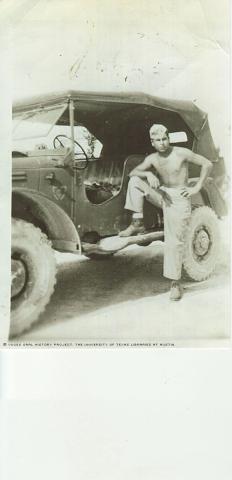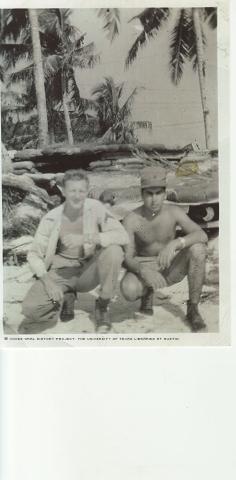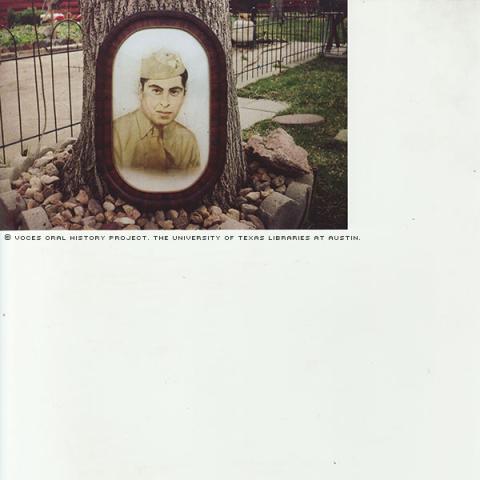


By Laura Lopez, California State University, Fullerton
Few people can claim to have been a veteran of three military branches.
And few can recall images of war as vividly as Jose Aragon did when, at the age of 84, he recounted his harrowing journey through World War II in the Pacific.
Three years before he was drafted, Aragon recalled when the attack on Pearl Harbor and the impact it had on his family.
"It was a terrible memory, Pearl Harbor. We would ration food, coffee meat, gas, shows... just about everything," he said.
Aragon was drafted into the U.S. Army in 1944. But when he arrived in San Diego, California, for basic training, he and fellow draftees were informed that the Navy needed volunteers.
"I volunteered to go into the Navy, then right before I began my training for the Navy, we were informed that volunteers for the Marines were needed. The sergeant told us, 'Ok, you, you, and you -- you'll be in the Marines,'" Aragon recalled. "And that was that: I went to the Marines."
Aragon's life prior to his military involvement was simple. He grew up in Weston, Colorado, the eldest of 18 brothers and sisters. Aragon's father, the late Juan Aragon, was a coalmine worker in Colorado and his mother, Maria Antonia Trujillo, a housewife. Aragon remembered working at the age of 4 with his siblings at a farm, cutting timber, as well as helping his father with work in the mines.
Growing up, the family didn't have much, although they got by with the help of everyone in the family.
"My father would buy material to make us clothing -- pants, shirts and so on," Aragon explained.
With such a large family, many traditions and memories were made. The Aragon family attended church every Sunday.
"We would go hunting and fishing to feed the family. I remember we would hunt in the winter with snow on the ground, and I would follow my father stepping in his footsteps," Aragon said with a chuckle.
Aragon attended the local Weston Primary School, followed by Primero High School. He was active in school sports, playing basketball, football, track and baseball.
"I was pretty good in basketball and football," Aragon said.
He made it to 11th grade, then dropped out because he wanted to make money. Aragon had held a janitorial job all through high school, but he wanted to work with his father. This was when Aragon learned he was being drafted into the military.
Aragon described Marine basic training as very physical.
"It was really rough. We did just about anything and everything," he said.
Aragon trained with machine guns, which involved a three-man crew. Aragon handled the gun.
Once completing basic, he was sent to Camp Pendleton in California for advanced training.
"This was my first time away from home, and I got used to it very quickly. My brothers and sisters would tell me how my mother would cry for me being away in the military," Aragon said.
"There weren't many Latinos at Pendleton. I was supposed to be promoted to 1st Sergeant; however I was given 'walking guard' instead. If I'd have known what I know now, I'd have fought it, but I didn't know better at that time," Aragon said.
In August of 1944, Aragon was sent to Pearl Harbor and spent over a month getting supplies ready and preparing weapons.
"We were trained that the Japs were cruel and would rather kill you then look at you. It was either they go kill you, or you kill them," he said.
In September 1944, Aragon boarded a ship bound for the Marshall Islands. The battle of Saipan earlier in the year was among the bloodiest for the Marine Corps. Aragon's ship arrived at Saipan in October 1944. Aragon saw first-hand what combat was like.
"There were lots of Kamikaze planes in the air. At one point we were all at the top of the ship watching a Kamikaze plane heading straight for a U.S fighter plane, firing away. Everyone yelled at us to get below deck and take cover. If it weren't for us taking cover and the U.S fighter plane, I don't think I'd be here telling this story," Aragon said.
Aragon spent his last few months serving in the Marine Corps in Peleliu (now called Palau) from Nov. 12, 1944 to May 1945, as part of the 3rd Base Headquarters Battalion, Fleet Marine Force Pacific (FMFPac).
According to an entry in the U.S. Marine Corps WWII Order of Battle by Gordon Rottman, the unit "provided island base commanders with staff, administration, security guard, supply, medical, construction, civil affairs, communications, chemical warfare defense, graves registration, legal, transport, ordnance, pay, and welfare support." The unit's strength was as low as 300 to 700 Marines, with another 40 or so Navy personnel.
With combat going on at Peleliu, Aragon and troops set up machine guns and slept in tents at night.
"You could see flares going up at night and the sound of shots being fired" Aragon said, recalling a battle in which Marine troops fought the Japanese on a hill to secure the remainder of the island of Peleliu.
"The Japanese kept their stuff there, supplies and what not. . . . We lost a lot of people there," Aragon said. The event ended up having a 71 percent casualty rate.
After a six-day battle, the Japanese surrendered and U.S. forces secured the island of Peleliu on November 27, 1944.
Aragon remembered a Japanese prisoner of war being held at their base camp, a situation that ended poorly. "One [of our] guys was furious and ended up shooting him. He later got court martialed," he said.
In May of 1946, Aragon, waiting to be discharged, was shipped to Guam. On June 6 of the same year, after serving for more than two years, he was discharged from the Marine Corps as a corporal.
On returning to the United States, Aragon did not take advantage of the G.I. Bill, which would have covered costs to attend college. Instead, he moved back to Weston to work at the same coalmine as his father.
"I never did go to college. I wanted to make money, and the mine was the only place to make money," he said.
Adjusting to civilian life was difficult.
"It was odd to not have someone telling me do this, do that. I was able to do what I wanted which was the best thing," Aragon said.
Aragon had other family members in the military: two younger brothers who served in the Air Force and another who joined the National Guard.
He married Susan Gallegos on May 4, 1945 in Trinidad, Colorado. The couple was together until Gallegos died in 1969. In October 1971 he married Elizabeth Duran, who had a son from a previous marriage, Ernesto Torres. Torres was serving in Vietnam with the Air Forces at the time of the marriage.
In 1982, Aragon retired from his work because of a disability. At the time of the interview, he had been married for 40 years to Elizabeth Duran Aragon.
Mr. Aragon was interviewed by Joseph Padilla in Aurora, Colorado, on February 26, 2011.

